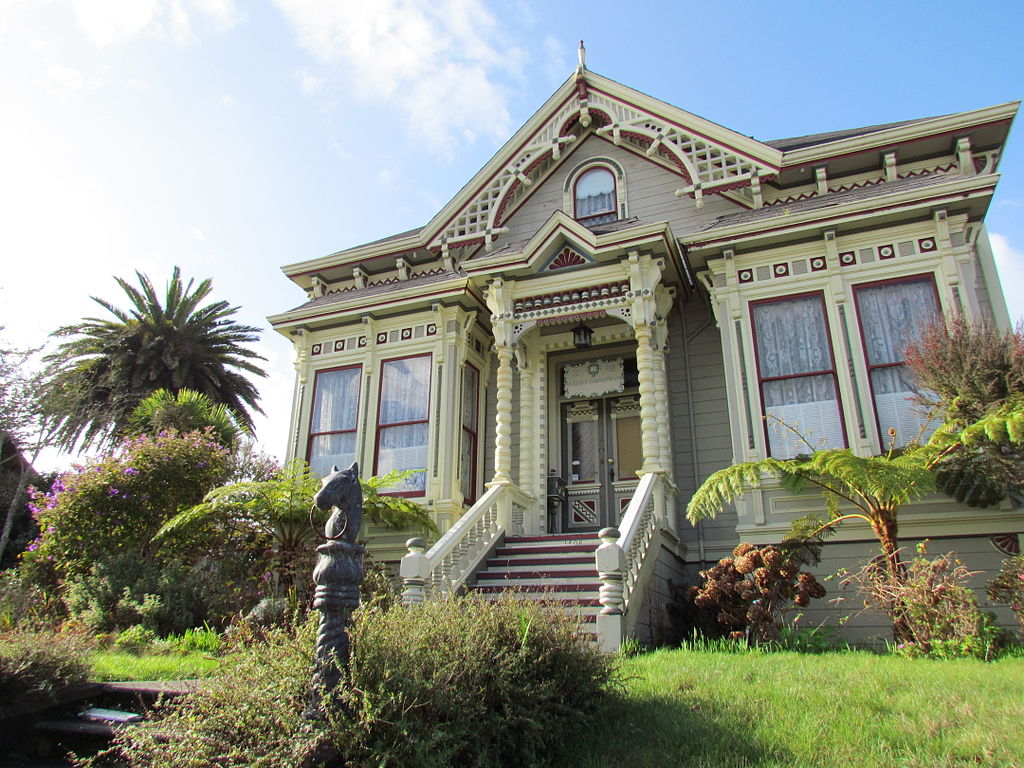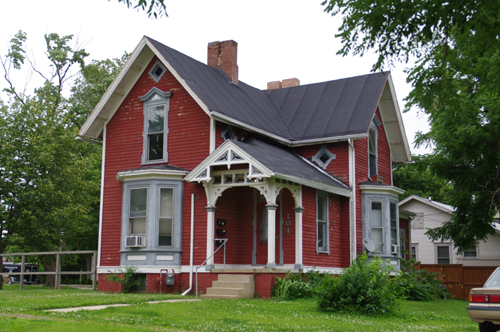Stick-Eastlake, 1870-1905
 |  |
The concept of truthfulness as expressed through construction is the basic tenet of the Stick Style. “Truthfulness” is expressed through the use of conspicuous external wall treatments and joints. Always of balloon-frame construction, the style is virtually only used for residential and religious structures. The Stick Style is quintessentially an American style developed between 1870 and 1905. This style emphasized the “frame” of a house - the vertical and horizontal wood elements that framed the exterior walls and the cross bracing that supplied stability. Early examples have walls faced with vertical boards and battens, but later examples used horizontal clapboards with an overlay of “framing.” This exterior “framing” was intended to express the internal construction of the building. Although the framing often looks like half-timbering, it was actually trying to express the modern (in its day) balloon-framing technique. However, these exterior wood elements are generally only superficial two-dimensional applied “structural” elements, such as diagonal bracing that “reveals” the internal structure of the building.
| |
In the Stick Style, height is emphasized with steeply pitched and intersecting gable roofs covering a complex or irregular plan. Roof eaves project outward and are supported by large brackets or lookouts. Often the gable end or apex has exposed decorative framing, such as embellished trusses. Porches roofs are carried on posts with bracing, generally simple diagonal or curved braces, and porches are usually one story. Shadow lines, as cast onto a surface by projecting members, were also important. The name “Stick Style” was coined by historian Vincent Scully as a counterpart to the balloon-frame structure of the house. This new construction system of slender, repetitive studs replaced the heavy timber frame as America’s way of construction. Roots of the style maybe found in the Gothic Revival, but Scully believes that its basis lies in the popular designs of Andrew Jackson Downing in the 1850s. Downing insisted in “truthfulness” in his designs. The style appeared in many house pattern books of the 1860s and 1870s.
| |
The later Eastlake derivation of the Stick Style furthered the application of exterior ornament. The style employed a variety of three-dimensional ornament that resulted from advances in woodworking machinery. The name derives from furniture designs illustrated in the widely popular Hints on Household Taste by Charles L. Eastlake, an English architect and designer, published in 1872, but American Eastlake architectural design was decidedly different from its English origins.
| |
During the 1860s, architect Charles Locke Eastlake returned to England’s medieval roots through the use of simple, solid forms with steep gables and picturesque massing. He was invoking a return to the early English manor house and reacting against the overproduced and exaggerated machine-made ornament of the times. Like Ruskin, Eastlake was promoting a return to buildings of “simplicity, honest, and propriety.” Eastlake’s 1872 furniture book provided interior designs to complement his architecture. His furniture was simple, of solid wood and with joints tenoned and pinned in the medieval fashion as opposed to the curves and carved ornament of the contemporary and popular Rococo Revival furniture. But Eastlake’s furniture designs took on an unexpected dimension in America and were transposed to architectural elements. His designs and motifs were applied to dwellings which had only the faintest connection with Eastlake architecture. Asymmetry was often maintained, as were steep gable roofs, but the emphasis shifted from solid simplicity of form to applied decoration. In this the American Eastlake Style joined the American Stick Style. | |
